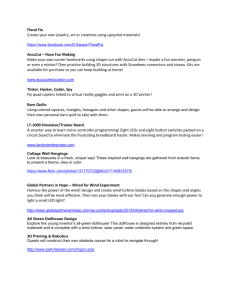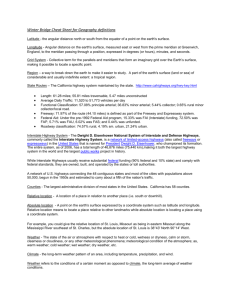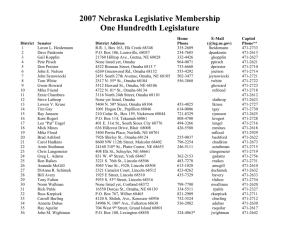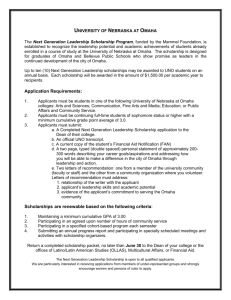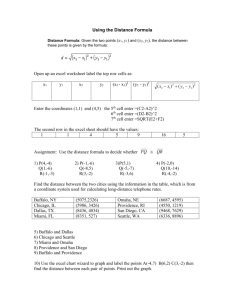Juliet Silberstein
advertisement
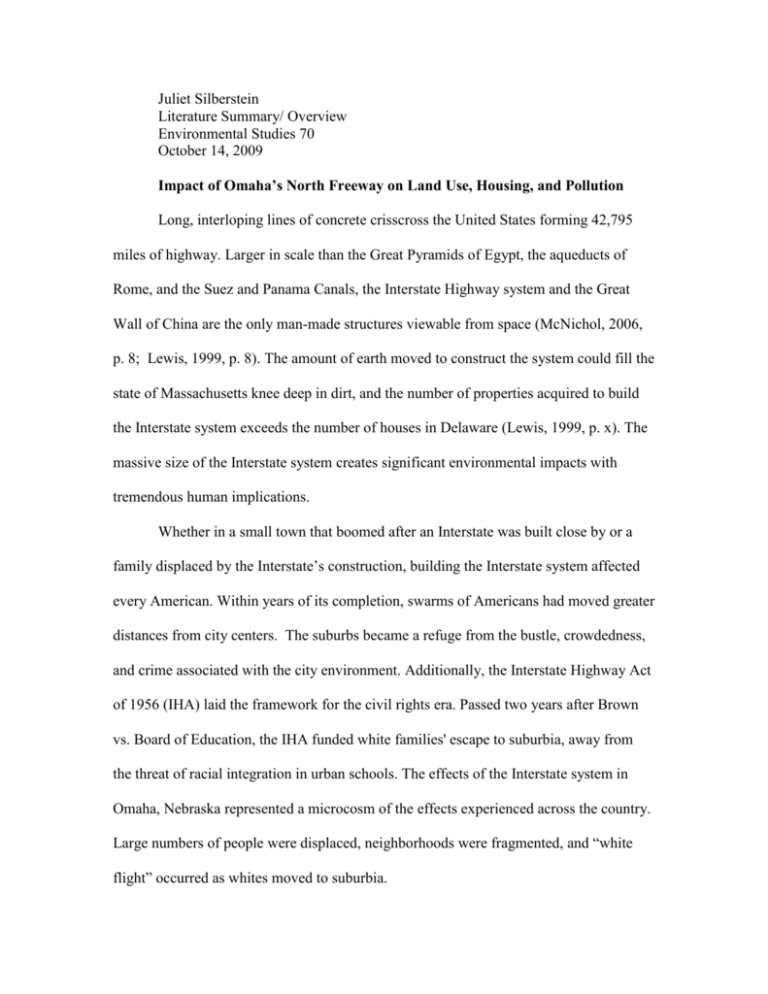
Juliet Silberstein Literature Summary/ Overview Environmental Studies 70 October 14, 2009 Impact of Omaha’s North Freeway on Land Use, Housing, and Pollution Long, interloping lines of concrete crisscross the United States forming 42,795 miles of highway. Larger in scale than the Great Pyramids of Egypt, the aqueducts of Rome, and the Suez and Panama Canals, the Interstate Highway system and the Great Wall of China are the only man-made structures viewable from space (McNichol, 2006, p. 8; Lewis, 1999, p. 8). The amount of earth moved to construct the system could fill the state of Massachusetts knee deep in dirt, and the number of properties acquired to build the Interstate system exceeds the number of houses in Delaware (Lewis, 1999, p. x). The massive size of the Interstate system creates significant environmental impacts with tremendous human implications. Whether in a small town that boomed after an Interstate was built close by or a family displaced by the Interstate’s construction, building the Interstate system affected every American. Within years of its completion, swarms of Americans had moved greater distances from city centers. The suburbs became a refuge from the bustle, crowdedness, and crime associated with the city environment. Additionally, the Interstate Highway Act of 1956 (IHA) laid the framework for the civil rights era. Passed two years after Brown vs. Board of Education, the IHA funded white families' escape to suburbia, away from the threat of racial integration in urban schools. The effects of the Interstate system in Omaha, Nebraska represented a microcosm of the effects experienced across the country. Large numbers of people were displaced, neighborhoods were fragmented, and “white flight” occurred as whites moved to suburbia. The ramifications of the Interstate system can be extrapolated by examining the neighborhood of North Omaha and the construction of Interstate-580 through the community. By 1960, approximately 10% of Omaha’s population was non-white, with 25,000 black residents, an increase of 54% from 1950 (A Report of the Discrimination in Housing of Minorities in Omaha, 1965, p. 19). During the post-war boom, Omaha prospered. The city became home to 38 insurance companies, an Omaha suburb (Bellevue) converted a wartime plant into Offutt Air Force Base, which housed the headquarters of the Strategic Air Command (Larsen et. al, 2007, p. 265), and Omaha remained the headquarters of the Union Pacific Railroad. Yet while Omaha flourished, its black population suffered. Approximately 8% of the black population lived in just nine tracts in North Omaha, which the inhabitants and other Omaha residents referred to as “the ghetto” (A Report of the Discrimination in Housing of Minorities in Omaha, 1965, p. 19). The center of the North Omaha neighborhood, North 24th Street, was beginning to die. Most of the stores had closed, and buildings were deteriorating (A Street of Dream, 1994). A segregation index based on the block analysis of cities from the 1950 census data ranked Omaha 14th out of 187 United States cities. The index ranged from 0.000 to 1.000, with 0.000 being completely racially integrated; notably, Omaha had a segregation score of 0.901 (A Report of the Discrimination in Housing of Minorities in Omaha, 1965, p. 24). The Interstate indeed ripped apart the North Omaha community, displacing 600 people over a 13-year period from 1970 to 1983 (“8 Omahans File Suit to Halt North Freeway,” 1983). More than 50% of the population would come up short by $3,000 to $5,000 when seeking to purchase a new home. Without adequate reimbursement for their homes, coupled with racial prejudice, many displaced people moved to one of the four housing projects in North Omaha (“Study Says Relocation Money Short,” 1975). Ironically, an extension of the North Freeway cut through the Omaha Housing Authority’s Spencer House, eliminating 57 units in 1983 to which previously displaced North Omahans had moved (King, 1982). The North Omaha community was displaced bit-by-bit over that 13-year period. Since the government provided these displaced citizens inadequate funds, they moved almost entirely to other houses or housing projects in North Omaha (“Study Says Relocation Money Short,” 1975). Throughout America in the 1950s and early 1960s, engineers situated highways through black neighborhoods. Robert Moses, the head of New York’s Bureau of Roads, leveled tens of thousands of black homes in order to expand New York’s highway system (Lewis, 1999, p. 189). To a great extent, the blacks displaced by Moses’ roads moved into his “urban renewal” high-rise apartments, thus subjecting them to sub-par living conditions (Lewis, 1999, p. 193). In Miami, an interchange for Interstate-95 demolished the city’s black business district and displaced more than 10,000 people (Mohl, 2008, p. 4). Planners shifted the North Central Freeway in Washington, D.C. from its original course through an upscale white community to a low-income black neighborhood (Mohl, 2008, p. 201). The stories of New York, Miami, and Washington, D.C. echoed throughout the country in places as varied as Baltimore, Milwaukee, Indianapolis, St. Paul, and New Orleans. As was the case in Omaha, the roads plowed through black communities (Mohl, 2008; Lewis, 1999, p. 210). The residents of North Omaha suffered from displacement and the bisection of their community while they watched whites move to the suburbs. Yet while the suburban whites resided some distance from the Interstates, the residents of North Omaha found themselves living, learning, and working next to a bustling thoroughfare. Richard F. Muth calculated in 1970 that the median income in American cities tends to rise at 8% per mile as one moves away from the business district, and that it doubles at 10 miles (Jackson, 1987, p. 8). The 1970 American Association of State Highway Officials published its “Report on Benefits of Interstate Highways,” which stated that in Washington, D.C., one minute less driving time from the central business district has been found to be the equivalent of $65 in the price of homes (Lewis, 1999, p. 212). Large cities saw the majority of their professionals living in the suburbs. By 1970, 78% of all attorneys, whose offices were in Newark, lived in the suburbs; approximately 75% of attorneys in Boston live in suburbia; and some 67% of New York City’s attorneys had moved to the suburbs as well (Jackson, 1987, p. 212). Omaha thus mirrored the trend of "white flight" across the country. The Interstate connected the Omaha suburb, Millard, to downtown Omaha in 1962. Over the next 10 years, the Millard School District grew by 975% (“Millard Public Schools - History of District,” n.d.). Yet while Millard flourished, members of the North Omaha community realized a decrease in the value of their homes when the North Freeway was built nearby, and some even complained that they were unable to find anyone they could pay to repair their residence (Rood, 1971). A study conducted by the University of Nebraska at Omaha: Center for Applied Urban Research concluded that only 10% of the North Omahans who had been displaced could afford housing in the suburbs (“Study Says Relocation Money Short,” 1975). Not only did inadequate finances force North Omahans to continue living in North Omaha, the Interstate also subjected them to increased pollution. By 1970, automobiles burned 130,000 gallons of gas each minute, and Americans spent $131 billion for highway transportation—in contrast to just $75 billion spent for education (Lewis, 1999, p. 212). In fact, the Interstate system and its subsequent usage created one of the world’s largest sources of pollutants. The pollutants from the Interstate system have affected the air of the neighboring communities, and have spread as well throughout entire cities and states. Many researchers have observed increased particulate matter and heavy metal pollution, and exposure to these chemicals has been linked to liver and kidney failure, as well as cognitive disorders (Dijkema et. al, 2008; Ozden et al., 2007; Clougherty, Wright, Baxter, & Levy, 2008). The pollution generated because of the Interstate system has proven to be a major health risk, which has significantly impacted the lower-income communities that are located near the highways. Before the above research was conducted, residents of North Omaha knew the threats of highway pollution and degradation to their neighborhood. Although the “Report on Benefits of Interstate Highways” stated that the highways “are also beneficial in reducing air and noise pollution levels,” eight black women filed suit alleging that officials had failed to comply with federal requirements for public hearings on the proposed extension of the North Freeway. The women argued that they were not adequately informed of the increased noise and air pollution that came with highways (Lewis, 1999, p. 212; “8 Omahans File Suit to Halt North Freeway,” 1983). Notably, the suit was dismissed, the highway was constructed, and pollution permeated their neighborhood (“Judge Refuses to Halt Highway,” 1983). The Interstate Highway System ripped through the North Omaha community and cut it in half physically. As with other highway construction projects, Omaha’s black community suffered as the whites moved to suburbia. Financially depressed, these North Omahans had no choice but to remain in the area that had been subjected to pollution and noise from the highway. The construction of the Interstate system in Omaha changed the city’s layout while further subjecting North Omahans to more crowded living arrangements, poverty, and pollution. Bibliography 8 Omahans File Suit to Halt North Freeway. (1983, September 4). Omaha World Herald. A Report of the Discrimination in Housing of Minorities in Omaha. (1965). Omaha, Nebraska: The Department of Planning. A Street of Dream. (1994). Great Plains National Instructional TV. Dijkema, M. B., van der Zee, S. C., Brunekreef, B., & van Strien, R. T. (2008). Air quality effects of an urban highway speed limit reduction. Atmospheric Environment, 42(40), 9098-9105. doi: doi: DOI: 10.1016/j.atmosenv.2008.09.039. Jackson, K. (1987). Crabgrass frontier : the suburbanization of the United States. New York ;Oxford: Oxford University Press. Judge Refuses to Halt Highway. (1983, July 1). Omaha World Herald. King, L. (1982, February 23). North Freeway Won't Grow in '82. Omaha World Herald. Larsen, L., Cottrell, B., Dalstrom, H., & Calame Dalstrom, K. (2007). Upstream Metropolis: An Urban Biography of Omaha and Council Bluffs. Lincoln: University of Nebraska Press. Lewis, T. (1999). Divided highways: building the interstate highways, transforming American life. New York N.Y.: Penguin Books. McNichol, D. (2006). The roads that built America: the incredible story of the U.S. Interstate System. New York: Sterling Pub. Millard Public Schools - History of District. (n.d.). . Retrieved October 14, 2009, from http://mps.schoolfusion.us/modules/cms/pages.phtml?pageid=97391&sessionid=7 6664ddd14c6c236f8714f686229385b. Mohl, R. A. (2008). The Interstates and the Cities: The U.S. Department of Transportation and The Freeway Revolt, 1966-1973. Journal of Policy History, 20(2), 193-226. Ozden, T. A., Gubiay, G., Ertem, H. V., Soglu, O. D., Kilic, A., Sokucu, S., et al. (2007). Elevated hair levels of cadmium and lead in school children exposed to smoking and in highways near schools. Clinical Biochemistry, 40(1-2), 52-56. doi: doi: DOI: 10.1016/j.clinbiochem.2006.07.006. Rood, M. (1971, January 28). Relocation: Slow, Sure. Study Says Relocation Money Short. (1975, January 16). Sun Newspaper.
